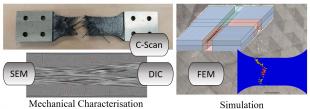Automated Fiber Placement (AFP) is an emerging technique to manufacture advanced composites for the aerospace industry. One of its main advantages is the possibility to define complex fiber paths to optimize the stiffness for a given loading scenario. One example of AFP three-dimensional reinforcement is AP-PLY (or Advanced Placed Ply), a novel strategy to produce pseudo-woven structures with improved impact resistance. The literature in AFP preforming is scarce due to the novelty of the manufacturing method, however, this technique has great potential to be widely adopted by high-value sectors such as aerospace and energy, substituting conventional autoclave and filament winding manufacturing methods.
Previous investigations by our research group have proved AP-PLY laminates retain the excellent undamaged in-plane tensile stiffness of conventional angle-ply laminates while limiting crack propagation, resulting in superior structural integrity after the optimisation of the internal architecture. Compressive response of AP-Ply laminates is a current open research question. Compressive response of aerospace structures is critical since their brittle response may result in internal delamination and failure due to buckling of thinner sublaminates. In AP-Ply laminates, tows present through-thickness undulations that introduce a three-dimensional reinforcement. Up to date, further investigations are necessary to determine the detrimental effect of tow undulations in in-plane compression properties, and optimise the internal architecture to avoid buckling of structural components.
Aim & Objectives
The aim of this project is to develop novel AFP preforms with superior compressive response. A coupled experimental and numerical approach is proposed to characterise the deformation and failure mechanisms and optimise the internal architecture. Three partial objectives are proposed.
- Characterisation of the micromechanical response of the undulated tow subjected to pure compression as a function of the undulation ratio and mismatch angle between adjacent tows.
- Characterisation of microbuckling in damaged samples as a function of the crack density.
- Homogenisation of the response at the mesoscale (tow level) and development of a failure criteria.
Acquired skills
The PhD student will have the opportunity to extent his knowledge in composite manufacturing technologies, advanced testing techniques, computational mechanics and coding. Multiple opportunities to develop soft skills and conduct scientific networking will be offered.
Informal inquiries can be made to:
Further Information:
The University of Edinburgh is committed to equality of opportunity for all its staff and students, and promotes a culture of inclusivity. Please see details here: https://www.ed.ac.uk/equality-diversity
Closing Date:
Principal Supervisor:
Eligibility:
Minimum entry qualification - an Honours degree at 2:1 or above (or International equivalent) in a relevant science or engineering discipline, possibly supported by an MSc Degree. Further information on English language requirements for EU/Overseas applicants.
Funding:
Applications are welcomed from self-funded students, or students who are applying for scholarships from the University of Edinburgh or elsewhere.



